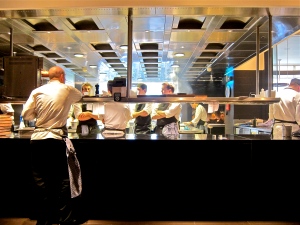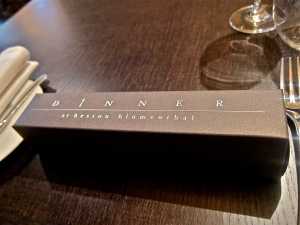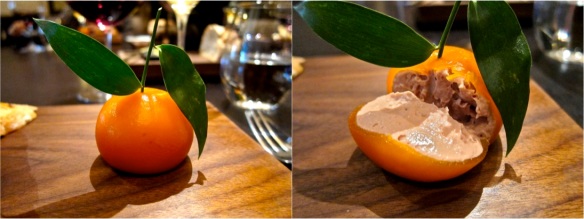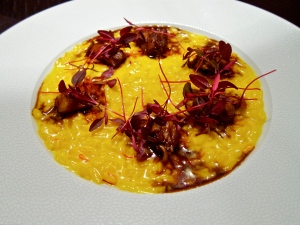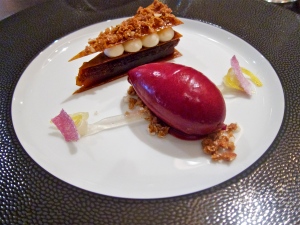Dinner by Heston Blumenthal – It’s Technically Delicious
Jun 19, 2011 in finer fare, laissez eats, ashley palmer-watts, bray, cockle ketchup, dale osborne, dinner by heston blumenthal, disznókö, earl grey ganache, fat duck. Read the original on: Laissez Fare
Dinner by Heston Blumenthal
at The Mandarin Oriental Hyde Park
66 Knightsbridge
London SW1X 7LA
Website
Map
Online Reservations … but you will likely need to try the old-fashioned way on +44 (0)20 7201 3833
- Menu: starters £13.50-16, mains £26-36, sides £4.50, desserts £9-12; the chef’s table accommodates up to 6 people and there is a minimum spend of £900 for the table
- You can view the entire set of photos from this meal on my Flickr site

Heston Blumenthal’s first London restaurant has set the UK’s food media into a frenzy. And with some good reason – the food is pretty good. In a similar vein to the Fat Duck, there is a lot of work that goes into the creation of each dish – both intellectually and in terms of the technical skill required to consistently replicate each deceivingly simple dish on a much grander scale than any of his Bray outposts. The kitchen generally pulls it off, and the service seemed to be pretty spot-on when we dined there (though we were at the chef’s table, so you would expect nothing less). Don’t come expecting the dramatic culinary theatre that Heston is famous for at the Fat Duck – and on many of his TV programs – as the dishes here are far more straightforward in their presentation, with a few exceptions. With a windowful view of Hyde Park – thanks to the newly installed floor-to-ceiling windows – and its very own Swiss watchmaker-fashioned rotating gas-fired rotisserie for pineapples, it’s definitely worth trying when in London.
Much ado about something
First things first. This post is late in coming. Very late. I won’t bore you with why, but apologies for the lack of activity for the last month or so.
This is the last of my posts from the at-one-point recent trip to London I made earlier this year. And what a way to end. But in every end there is a beginning, as one of my favorite poets often said.
The only way I could actually score a table at what was then being billed by most as the hottest restaurant opening in London in a long time, and by some as the best new restaurant in the world (which was probably taking things a little too far), was to book the chef’s table. When I enquired, I found out that there is technically no fee for booking the table, but there is a minimum spend of £900, which can be split amongst up to six guests…so definitely the more the merrier. The £150/person price, in the case of six, pays for the tasting menu, which enables you to sample much of the à la carte menu. Drinks and service will cost extra.
One small point, which relates smaller people. We wanted to bring our daughter with us (who at the time was nine months old), and although this seemed to present a problem at first, the issue was eventually resolved (indeed, there had been no issue in the first place but we seemingly had been misinformed the first time around), though not without some time and effort.
In any case, I will assume for the benefit of most readers that you know who Heston Blumenthal is (if not, see my previous review of his Michelin 3-star restaurant in Bray), and that you know that ‘Dinner’ is his first restaurant in London. You can read about the word play – a typical example of Heston’s historical whimsy – on the restaurant’s website or in many of the other reviews out there. Apparently, the Mandarin Oriental, in which the restaurant is housed, insisted that they use his name on the masthead, even though he personally will not be the chef at the restaurant – a fact he has been refreshingly transparent about from the beginning. Heston’s right-hand man, Ashley Palmer-Watts is in charge of quite literally a small army of chefs (there are more than 40) and kitchen staff, most of whom remain cleverly shielded from the restaurant’s customers, who are likely none the wiser.
There are 126 covers at Dinner, which makes it by far the largest of Heston’s restaurants – the Fat Duck only has about 40 covers by comparison, and his two pubs in Bray (the Hinds Head and The Crown) are also far smaller. The part of the kitchen that is visible to diners is open, though mostly covered by a sheet of glass that comes down from the ceiling. There are two large islands in the kitchen, which were custom-made by Rorgue, that utilize multi-point induction hobs. As many readers will already know, Heston is well-known for using the sous-vide (or ‘water bath’) method for cooking many of the proteins in his dishes, and there are correspondingly seven large built-in water baths in the main kitchen itself. There is also a Josper oven, which can reach temperatures of over 930° F, which is used for the beef dishes.
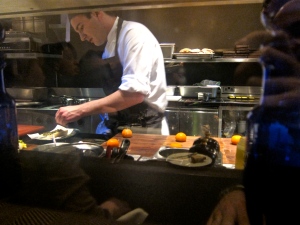
A chef in the hidden prep kitchen behind the chef’s table (the thin windows can be automatically made opaque whenever they wish so diners can’t see through)
In addition to all of this, there is a pastry kitchen, which is more or less hidden behind the chef’s table, and there are more prep kitchens located out of site in the bowels of the hotel.
The design of the restaurant is pleasant enough, without demanding your attention. But once you begin to look around, you do notice that in true Heston style, no detail in this Adam Tihany designed room has been left unconsidered. The space is very open, with high ceilings and floor-to-ceiling windows that were newly installed with the changing of the restaurant’s guard. Brown and gray hues dominate the lower reaches, with wood flooring, unadorned wooden tables, and classy cushioned banquettes. Then there are the oft-noted jelly mold (or possibly cake mold) lamps and the Swiss watchmaker Ebel-designed chrome and steel pulley-operated rotating gas fire rotisserie…for what else but pineapples. The front of house is also smartly attired in well-tailored suits and waistcoats.
Being at the chef’s table, we had the benefit of each course being presented by the head chef himself. The table itself is very spacious and comfortable for the full party of six, and is arranged in a u-shape that directly overlooks the pass of the semi-open kitchen. Ashley wasn’t there on the day of our visit, but we couldn’t have been happier with the extremely personable Sous Chef Dale, who was heading up the kitchen in his absence.
With Baby LF comfortably seated in one of the corners of the bench seating, some of us opened the beautiful boxes that had been laid down in front of us to peruse the tasting menu.
Lunching at Dinner
The good thing about sitting at the chef’s table is that you get to try a lot of what the normal menu has to offer. In fact, there are no special courses, but rather tasters of the à la carte menu, plus a little surprise at the end which has not yet been rolled out to the main dining room so far as I am aware.
We did have a quick a look at the menu, although you can obviously keep it a surprise and take it home as a souvenir. However, I wanted to ensure we would be able to taste all of the dishes I had in mind – by this point I had distilled all of the reviews into a list of must-try dishes – so we ended up adding a couple more things to share between the table, something the kitchen was happy to accommodate.
While we waited for the first course to arrive, we nibbled on some good quality bread and salted butter, and got comfortable in our little semi-private enclave.
This was a pleasant, light and flavorful beginning to the meal. Gentleman’s relish is the nod to history within the dish. Also called patum peperium, it is basically an anchovy paste, which in this case was quite mild and was formed from garlic and anchovy paste as well as a lemon mayonnaise. The pickled lemon salad on top interplayed well with the smoked mackerel, which had a good texture to it. It was perhaps not the most cleanly plated dish, but the flavors worked harmoniously and I enjoyed it. 7/10.
I don’t think there is much to say about this dish if you have already read about it elsewhere. Suffice to say that if you did not know that the inside consisted of chicken liver parfait, you could easily be forgiven for thinking it was an actual mandarin orange, so accomplished was its guise (for those interested, the parfait is frozen so that the gel can set and then it defrosts naturally). The only thing that was not edible was the faux stem and leaves plucked into the top of the creamy spread. What I will say is that the mandarin flavor provided by the outside jelly casing provided a faint but lovely citric counterpoint to the rich foie gras pâté. Jelly is historically a common partner to foie gras, so perhaps this was the nod to the past that the dish was going for. The bread was grilled nicely, with five distinct lines of char, and was the perfect vessel to carry this little ball of mandarin madness to your eagerly waiting mouth. (As a side-note, I am sure the hotel is not too upset that the this dish has almost become the mascot for the restaurant given the fruit after which it was fashioned ![]() ). 9/10.
). 9/10.
Much like Billy Joel, we were quite content with a bottle of white and a bottle of red for our meal (even though it wasn’t an Italian restaurant) as not everyone was drinking. However, with the meat fruit I sort of made people have a glass of this above Tokaji. Good thing too, because it was pretty remarkable. It was elegant and had a lingering clean finish that kept it from being anywhere in the vicinity of cloying, and it paired remarkably well with the meat fruit. Highly recommended.
This dish seems to have gotten a bad rap from many people who have been to the restaurant and reviewed or commented on it. I am happy to be contrarian here as everyone at our table – including me – thought it was pretty excellent. Maybe it was because ours had quail, and I think that the version most people have had contains chicken oysters instead. The quail’s breast was very nicely cooked and went well with the little wobbly discs of bone marrow and the roasted vegetables. The dish was bound together by a horseradish fluid gel, which was made from milk that had been infused with horseradish and then thickened. Some people have commented about the (lack of) quality of the salad leaves, but they seemed perfectly acceptable to me on this occasion. The plating, as with the first course, did seem a little haphazard, but I guess this was purposeful. 8/10.
There were lots of varieties of ketchups swimming around before Mr. Heinz reared his head (there is cockle, cucumber and mushroom ketchup on Dinner’s menu alone), and this was the historical element in the turbot dish. Besides the fish, there were baby chicory leaves which were quite bitter and some cockle ketchup which was meant to offset the astringency; the ketchup was made from thickened mussel stock, combined with fresh cockles, capers, gherkins, pickled lemons, pickled shallots, herbs and a tiny bit of tartar. Unfortunately, I don’t think anyone enjoyed the flavors of this dish too much, although the turbot was skilfully cooked. A persistent taste of the sea, which was not particularly pleasant to me, seemed to overwhelm everything else on the plate. Possibly someone else’s cup of ‘t’, but not mine sadly. 5/10.
Our palates were soon enjoying themselves again, however, as the next course was one of the favorites of the afternoon. This was one of the best pork chops I have ever tasted. We were only given a few slices each, but the whole chops are very thick and come from the fabled Spanish Pata Negra pigs which have excellent marbling that helps to create a very juicy piece of meat. The crunch from the cabbage and the punchiness from the small amount of the modernized Sauce Robert were the perfect complements for this perfectly simple dish. This was a case of sous-vide cooking working perfectly. The texture wasn’t gummy and it almost felt as if you were eating a fine piece of steak. 10/10.
I had forgotten to order some of Heston’s famous triple-cooked chips, but luckily the kitchen had taken care of this without me asking, and was kind enough to bring out a number of little tins of these thick-cut beauties. They were simply divine. Although I do prefer a thinner frites, it is hard to argue that these are not textbook perfect – so crispy on the outside and so soft and luscious at the core. It was a wonderful bit of starch to go with the last savory dish, which arrived at the same time. 10/10.
Dale explained that when they were doing their research for the menu, they came across two historic pigeon dishes, one served with ale and one with artichokes. So they decided to combine these. The pigeon breasts had been gently cooked in a water bath at 56° C for 20 minutes, which rendered them nice and tender; however the skin did have some welcome crispy caramelization to it. Amongst the artichokes were also sprinkled a smattering of onions, rocket and thyme, and the pigeon sauce was finished with an organic ale, which was fairly bitter – but this contrasted nicely with the sweetness from the artichokes and onions. Mrs. LF has never to my knowledge enjoyed a pigeon, but she couldn’t stop raving about this one. I had been worried that the sous-vide cooking might make it a very bland dish (I have recently had meals at very accomplished restaurants where this method took the enjoyment out of the main meat courses) but it again worked well in this instance and made for a thoroughly enjoyable and memorable dish. 10/10.
The first of the sweeter dishes was upon us, and there was a bit of controversy here. Most people didn’t care for it too much, but more interestingly, all of us could swear that we tasted beetroot somewhere in the dessert. Not that this was a bad thing, but the kitchen confirmed that this was definitely not the case. We were stumped. So far as I could tell, it was composed of a rhubarb sorbet with fromage blanc and rosehip jam beneath it, plus a (possibly raspberry) tuile. The beautifully presented stalk of rhubarb on the side had been soaked in Campari and was nice enough. It was a fresh and pleasant dessert but the taste of it certainly didn’t wow me. 5/10.
I decided to have a closer look at the craziness of the pineapple grilling apparatus, and got a few pictures of the glazing process. It may be gimmicky, but it is a pretty classy gimmick if you ask me. Luckily, I got to taste the fruits (literally) of the poor pineapple glazer’s labor a little while later.
This was without a doubt my favorite of the desserts we sampled. The brioche cake was soaked in the most luscious mix of sugar and brandy (and quite a bit of brandy, hence the name). I can never get very excited about bread and butter pudding – although it is one of Mrs. LF’s favorite things – but I would definitely look forward to eating this most nights. The effect of the rotating roasting on the pineapple was perfect as it had been cooked evenly through and was nicely caramelized on the edges. I thought it was a marriage made in heaven. 9/10.
We had eaten what I believe was pretty much the same dessert at the Fat Duck a while back, and I remember writing that besides being one of the most beautiful desserts I had ever come across, it was also truly delicious. I don’t know if my taste buds have moved on or what, but I just didn’t enjoy it this time around. The dessert divided opinions around the table, as had a few of the earlier courses, and I was very let down as this was one of things I was most looking forward to. It still looked very pretty, though instead of being rectangular it was now triangular, reminiscent of the poshest slice of pie you might ever see. It consisted of caramelized puff pastry, and from the bottom up there was a caramel jelly, then caramelized apple, then fromage blanc with rosewater. Beside the blackcurrant sorbet were some crystalized rose petals, fennel seeds, apple fluid gel and some actual fennel. To me the sorbet was too strong and the lovely apple flavor I remember from the Fat Duck version seemed to be absent this time around. 5/10.
I am not quite sure how the white futuristic ice-cream trolley, from which ice cream is fashioned before you through the use of liquid nitrogen, harkens back to the Halcyon days of British gastronomy, but this is Heston, so you have to give him some leeway, right? In any case, the pastry chef came out of the kitchen and whipped it up in front of us. They said they were still trying to work out some of the kinks with the machine and this is apparently the reason that they haven’t brought it out to the main dining room yet. They said they wanted to make it look like it could have actually been a mixer of some kind way back when, which I guess they have succeeded in doing, but I am not sure why they made it look like something from the Jetsons instead of something more archaic (like they did with the spit roast, for example).
In any case, there was only one option in terms of flavors: vanilla. So we all had this plus any combination of the four toppings we wanted. I chose freeze-dried raspberries, as the above picture can attest. I didn’t particularly like the ice cream itself because it was simply too soft and hadn’t set properly yet (you can also see this from the photo, which was taken right after it was handed to me). The cone, however, was downright delectable, and was made in-house. After so much of a build up, the ice cream was a bit of a let down. I am sure they will perfect it eventually though. 5/10.
This intensely sweet concoction was served in a little teacup (without a handle) and saucer in a nod to the tea-flavored component of the ganache. I found it slightly awkward to eat and it was also a little too sticky and sweet of an ending for me. The bergamot taste came through well, but it was just too overwhelming for me after all we had eaten. 5/10.
All’s well that ends well
I don’t want you to get the wrong idea of my overall feelings about the restaurant from the somewhat mixed thoughts I (and my friends and family) had about the food. Generally speaking, there is a tremendous amount of technical skill that goes into each dish at Dinner before they even make it to the open kitchen to be finished for serving. There is also a ton of thought put into not only the historical inspirations behind the dishes, but also into the flavour combinations and balance of textures within each plate of food. While it may not be presented as fancily (or fancifully) as it is at the Fat Duck, the technical prowess of the kitchen would be hard to fault. However, this undertaking is at the other end of the spectrum from other new and interesting restaurants in London and elsewhere, which tend to focus on the quality of the produce itself and attempt to let the natural ingredients speak for themselves to different extents. These establishments do not employ the technical wizardry (or the 45 or so chefs) that Dinner does. This doesn’t make one better or worse than the other, as the enterprises have very different philosophies and aims, but it does make it a very different experience. [1]
Our own experience at Dinner was overall a very positive one. From the moment we were greeted and seated at our table, we were exceedingly well looked after. (The only instance where this didn’t happen was right toward the end as service was winding down, where things seemed to lag a little bit). Mathilde (@mathildecuisine), who joined us for the meal, was observing Lent at the time and they catered to her needs well from what I could see. Being Mathilde, when Mrs. LF asked the kitchen for some yogurt for Baby LF, she also asked for some too. Yes, this is the same woman who asked for hot chocolate at noma when only tea and coffee were offered ![]() . As with the Danish hot chocolate she received then, she was very impressed by the quality of the simple offering of yogurt at Dinner.
. As with the Danish hot chocolate she received then, she was very impressed by the quality of the simple offering of yogurt at Dinner.
I generally enjoyed the food, but the lows and highs seemed to be more exaggerated that I had expected they might be. I suppose the only dishes I didn’t really enjoy were the roasted turbot and the Taffety Tart. Although a few of the other dishes didn’t stimulate my taste buds all that much, the pork, pigeon and tipsy cake were pretty amazing in their own right.
I didn’t feel like a lot of things were all that new at Dinner (though their descriptors may try to convince you otherwise with their historical verbiage) but I did think a lot of things were excellent. And they made us feel very comfortable. We had a lovely long lunch, with Hyde Park as our backdrop, and got to catch up with old friends in a splendid setting. And you can’t really complain too much about that. [2]
Rating
Ambience: 8/10 (for the chef’s table only; I haven’t dined in the main room)
Service: 8/10 (again for the chef’s table)
Food: 7/10
Wine: the list is comprehensive (as you would expect) but the mark-ups can be stiff, and seemed to average about three times what it would cost you in a retail shop.
For more about my rating scale, click here.
*Note: I have dined at Dinner by Heston Blumenthal once, and it was for lunch at the chef’s table*Â
*Note regarding the title: In case you were wondering (I know you weren’t), the title of the review is a play on words with regards to the famous jingle (in America) for the iconic breakfast ‘cereal’ Lucky Charms.*
[1] For example, this other breed of restaurants – call it the ‘new naturals’ or what you will – also focus heavily on seasonality and availability of local ingredients, whereas I could envisage the menu at Dinner could remain more or less the same throughout much of the year, serving what it wants to serve, rather than what is abundant and fresh during each season. This is not a criticism so much as an observation.
[2] One thing I think they should watch out for is not to fall into the same trappings of the Fat Duck with regards to the menu remaining fairly static over time. As this is a larger restaurant and people will be able to return more easily than at the Fat Duck, they need to mix things up to keep it interesting for diners. I would also humbly suggest that they try to at least acknowledge the changing of the seasons when introducing new menu items.
Filed under: Finer Fare, Laissez Eats Tagged: Ashley Palmer-Watts, Bray, Cockle Ketchup, Dale Osborne, Dinner by Heston Blumenthal, Disznókö, Earl Grey Ganache, Fat Duck, Gentleman's Relish, Hay Smoked Mackerel, Heston Blumenthal, Knightsbridge, London, Mandarin Oriental Hyde Park, Marrowbone, Meat Fruit, Michelin 3 Star Chef, Nitro Ice-Cream Trolley, Pata Negra, Restaurants, Risotto Milanese, Roast Quail, Rosehip Jam, Salamugundy, Sauce Robert, Significant Openings, Spit-Roast Pineapple, Tokaji, Triple-Cooked Chips

Read the original on: Laissez Fare
Laissez Fare, Laissez Fare
I am inspired by food, wine and travel, and have created Laissez Fare to record my experiences and thoughts about the places I've visited and the things I've tasted.
